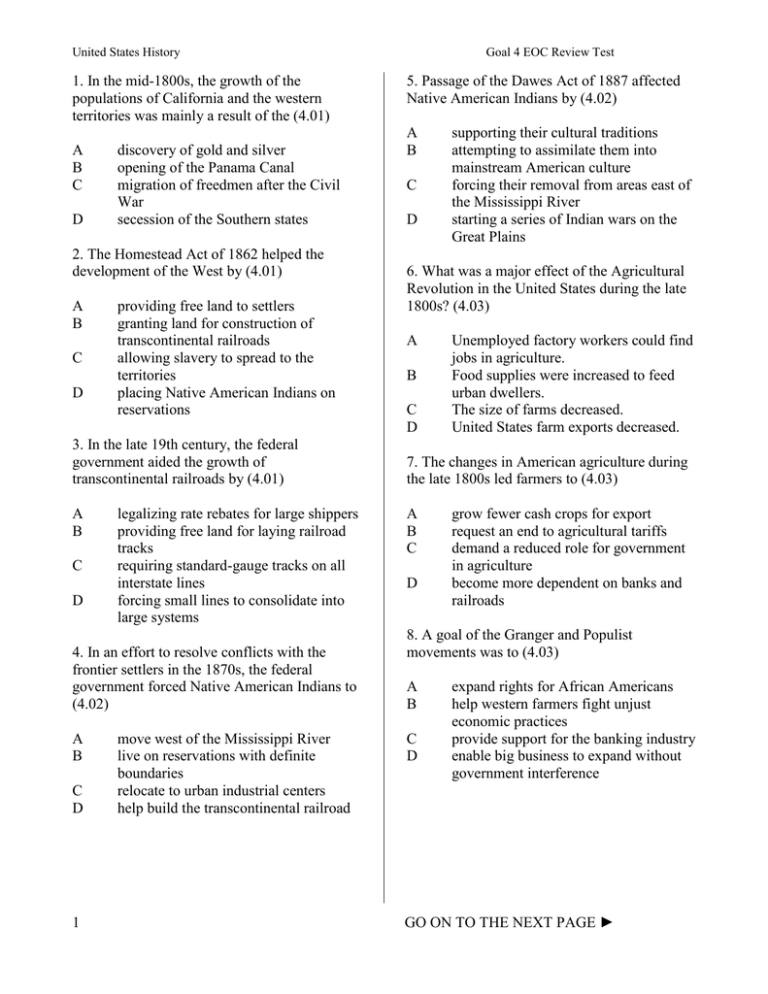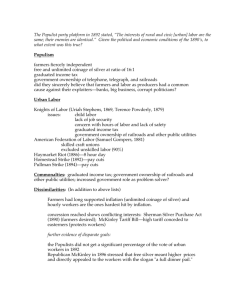1. In the mid-1800s, the growth of the
advertisement

United States History 1. In the mid-1800s, the growth of the populations of California and the western territories was mainly a result of the (4.01) A B C D discovery of gold and silver opening of the Panama Canal migration of freedmen after the Civil War secession of the Southern states 2. The Homestead Act of 1862 helped the development of the West by (4.01) A B C D providing free land to settlers granting land for construction of transcontinental railroads allowing slavery to spread to the territories placing Native American Indians on reservations 3. In the late 19th century, the federal government aided the growth of transcontinental railroads by (4.01) A B C D legalizing rate rebates for large shippers providing free land for laying railroad tracks requiring standard-gauge tracks on all interstate lines forcing small lines to consolidate into large systems 4. In an effort to resolve conflicts with the frontier settlers in the 1870s, the federal government forced Native American Indians to (4.02) A B C D 1 move west of the Mississippi River live on reservations with definite boundaries relocate to urban industrial centers help build the transcontinental railroad Goal 4 EOC Review Test 5. Passage of the Dawes Act of 1887 affected Native American Indians by (4.02) A B C D supporting their cultural traditions attempting to assimilate them into mainstream American culture forcing their removal from areas east of the Mississippi River starting a series of Indian wars on the Great Plains 6. What was a major effect of the Agricultural Revolution in the United States during the late 1800s? (4.03) A B C D Unemployed factory workers could find jobs in agriculture. Food supplies were increased to feed urban dwellers. The size of farms decreased. United States farm exports decreased. 7. The changes in American agriculture during the late 1800s led farmers to (4.03) A B C D grow fewer cash crops for export request an end to agricultural tariffs demand a reduced role for government in agriculture become more dependent on banks and railroads 8. A goal of the Granger and Populist movements was to (4.03) A B C D expand rights for African Americans help western farmers fight unjust economic practices provide support for the banking industry enable big business to expand without government interference GO ON TO THE NEXT PAGE ► United States History 9. In the late 1800s, the Granger movement tried to improve conditions for farmers by (4.03) A B C D Goal 4 EOC Review Test Base your answer to question 12 on the cartoon below and on your knowledge of social studies. lowering the rate of inflation strengthening the gold standard forcing railroads to lower their rates making labor unions stronger 10. The success of the Populist Party of the 1890s can best be measured by which development? (4.03) A B C D The party replaced one of the two major parties. The party gained support among business leaders. Two of the party’s candidates were elected to the presidency. Several of the party’s proposed reforms were made into laws. 11. During the late 1800s, many farmers supported the idea that free and unlimited coinage of silver would (4.03) A B C D end farm subsidies help farmers to repay their loans lead to lower prices for consumer goods decrease prices for farmland Source: Mark Sullivan, Our Times, Vol. 1, The Turn of the Century (adapted) 12. This cartoon from the 1896 presidential election campaign attacked William Jennings Bryan’s proposal for (4.03) A B C D 2 free coinage of silver lower tariffs on farm goods strengthening the gold standard government regulation of the railroads GO ON TO THE NEXT PAGE ►


